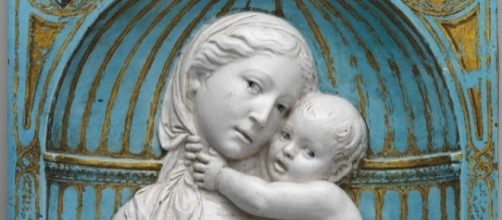While the National Gallery current show title, “Della Robbia: Sculpting with Color in Renaissance Florence” stresses the advent of bright-hued glazes to the art form, the technique invented by the Della Robbia family of artists, isn’t its only charm.
Certainly, splashy, high-colored sculpture was a novelty. But Luca Della Robbia’s figure “Virgin and Child in a niche” also conveys something else special – the human heart - which is at least as spectacular as enhancing sculpture with pigment.
The heart of the matter
This is especially true since the world had just gotten through the Middle Ages when artists portrayed us in life after death rather than what it’s like to be alive and, in particular, become a mother.
Consider Luca Della Robbia’s vision of maternity, “Virgin and Child,” which describes a female clasping her child who hugs her back.
The sculptor tells the story of divine devotion as a human condition. Mary is not some flat figure toting her young as if a sports trophies. The sense of love in this sculpture is not unlike that in Michelangelo’s version of motherhood, “Pieta,” which shows Mary holding the same son now crucified.
Another human condition
This Della Robbia show brings to mind another aspect of being human, though admittedly far less sentimental – the commonality of human error and how it impact on the art world. I’m thinking of a Della Robbia terracotta at the Met, “St. Michael the Archangel Weighting Souls” plummeting to a stone floor from its perch over a doorway in 2008.
It landed on its back allowing the archangel’s face to stay whole. The work survived some six centuries of history, war, and pestilence, and ended up in pieces in a treasure house where those handle it wear gloves.
The Met has a lot of Della Robbia work, but this one is said to be of greatest importance. I grant you that art accidents are far and away from the subject of motherhood.
But free-association is part of the art experience, and this is what else the Della Robbia work suggested.
You did what?
In 2006, the human error raised its inelegant head when art collector Steve Wynng, readying to sell Picasso’s “Le Reve” for an agreed-upon price of $139 million, rammed his elbow into the canvas and tearing it.
It cost $90,000 to repair the damage, and the work’s value plunged to $85 million.
Then in 2010, another Picasso got damaged when a woman tripped and knocked into “The Actor,” likewise ripping it. And in 2000 when a workman at Sotheby’s auction house in London used a crushing machine to mash up boxes, one of them contained a Lucian Freud painting.
A year later, an art gallery staffer in London trashed a work by Damien Hirst because the artist’s pile of loaded ashtrays, coffee cups, and beer bottles resembled trash. Admittedly again, all this has nothing to do with motherhood, but it all adds up to the human experience, doesn’t it?


